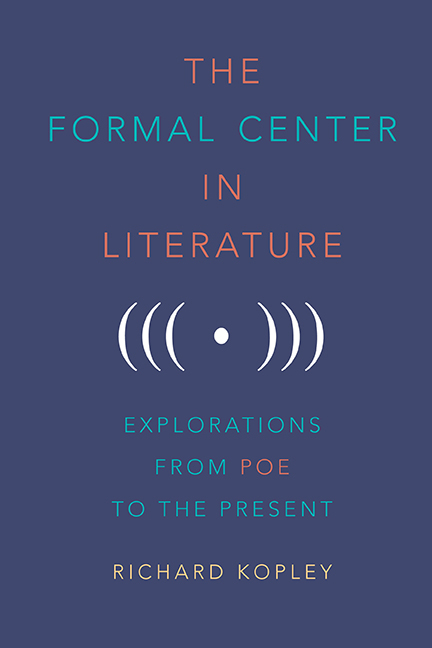Book contents
- Frontmatter
- Dedication
- Contents
- Acknowledgments
- Introduction
- 1 “Mournful and Never-Ending Remembrance” in Edgar Allan Poe's The Narrative of Arthur Gordon Pym
- 2 Retracing Our Steps in Edgar Allan Poe's “The Man of the Crowd”
- 3 “Scrutinizing the Parchment More Closely”: The Form of “The Gold-Bug” and Its Relationship to That of the Dupin Tales
- 4 Form and Reform in Nathaniel Hawthorne's “Earth's Holocaust”
- 5 The Circle and Its Center in Herman Melville's “Bartleby, the Scrivener”
- 6 Chiasmus in Henry David Thoreau's Walden
- 7 The Mythological Centers of Lewis Carroll's Alice Books
- 8 Table as Text in James Joyce's “The Dead”
- 9 The Structure of Sherwood Anderson's “Hands”
- 10 The Architecture of Ernest Hemingway's “The Three-Day Blow”
- 11 Balance in Dashiell Hammett's The Maltese Falcon
- 12 Framing Caesar in Raymond Chandler's The Big Sleep
- 13 The Ridge of the Domino in Patricia Highsmith's Strangers on a Train
- 14 The “X in the Air” in Joyce Carol Oates's “Where Are You Going, Where Have You Been?”
- 15 The Hybrid Center of Zadie Smith's White Teeth
- Notes
- Bibliography
- Index
8 - Table as Text in James Joyce's “The Dead”
Published online by Cambridge University Press: 14 June 2019
- Frontmatter
- Dedication
- Contents
- Acknowledgments
- Introduction
- 1 “Mournful and Never-Ending Remembrance” in Edgar Allan Poe's The Narrative of Arthur Gordon Pym
- 2 Retracing Our Steps in Edgar Allan Poe's “The Man of the Crowd”
- 3 “Scrutinizing the Parchment More Closely”: The Form of “The Gold-Bug” and Its Relationship to That of the Dupin Tales
- 4 Form and Reform in Nathaniel Hawthorne's “Earth's Holocaust”
- 5 The Circle and Its Center in Herman Melville's “Bartleby, the Scrivener”
- 6 Chiasmus in Henry David Thoreau's Walden
- 7 The Mythological Centers of Lewis Carroll's Alice Books
- 8 Table as Text in James Joyce's “The Dead”
- 9 The Structure of Sherwood Anderson's “Hands”
- 10 The Architecture of Ernest Hemingway's “The Three-Day Blow”
- 11 Balance in Dashiell Hammett's The Maltese Falcon
- 12 Framing Caesar in Raymond Chandler's The Big Sleep
- 13 The Ridge of the Domino in Patricia Highsmith's Strangers on a Train
- 14 The “X in the Air” in Joyce Carol Oates's “Where Are You Going, Where Have You Been?”
- 15 The Hybrid Center of Zadie Smith's White Teeth
- Notes
- Bibliography
- Index
Summary
GOING FROM LEWIS CARROLL's Alice's Adventures in Wonderland to James Joyce's short story “The Dead”—the celebrated final work in his 1914 collection Dubliners—we step from one quadrille to another. Indeed, Martin Gardner comments, “‘Lobster Quadrille’ could be an intended play on ‘Lancers Quadrille’” (100–101n1), and the “Lancers Quadrille” is the one that Gabriel Conroy and Molly Ivors dance in “The Dead.” Garry Leonard has suggested that “The hyper-symmetrical action and reaction of the dance acts as an ironic counterpoint to the frightening misrecognition that occurs between Gabriel and Molly Ivors.” However, it should be added that the dance's very symmetry may hint at the story's symmetry. We may be attentive especially to a symmetry of language—as Clive Hart has observed, “there are unmistakable signs at least as early as ‘The Dead’ of the deliberate use of verbal motifs for structural and tonal effects.” But that symmetry must be sought—it is not the case that, as Peter J. Rabinowitz maintains, “The narrative's formal design, after all, is fairly straightforward.” Joyce's presentation of a holiday party and its aftermath in Dublin—revealing the protagonist Gabriel Conroy's growing self-doubt, culminating in his eventual chastening and epiphany— does indeed involve a subtle verbal symmetry, framing a significant center in the second section of the story's three sections. And, I will argue, that center—the laden supper table—serves as a mise en abyme, a deft representation of the story itself.
Our identifying the symmetry may be gently encouraged by the narrator's stating of the piano performance of Gabriel's cousin, “He [Gabriel] knew that Mary Jane must be near the end of her piece for she was playing again the opening melody” (187). And scholars have noted pairings, which turn out to be symmetrical. For instance, John V. Kelleher has mentioned “Cab windows rattling” (180) and “a cab … its rattling noise” and “old rattling box” (214). John Wyse Jackson and Bernard McGinley have mentioned that “the crow … makes its second appearance in the story” (“crow to pluck” [187] and “hoarse as a crow” [211]). Several scholars comment on the parallel scenes involving Gabriel's reverie about the Dublin cityscape.
- Type
- Chapter
- Information
- The Formal Center in LiteratureExplorations from Poe to the Present, pp. 69 - 74Publisher: Boydell & BrewerPrint publication year: 2018



